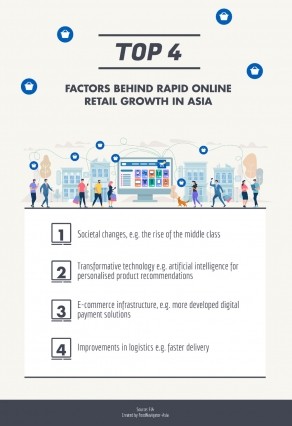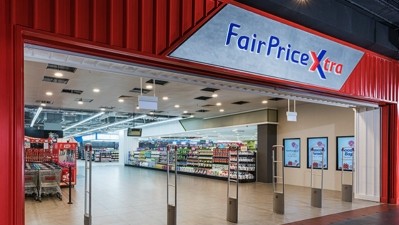Asia's Food Future: Industry 4.0
Food and beverage e-commerce: The future for retail, logistics, payment and personalisation

In this edition of Asia’s Food Future: Industry 4.0, we take a closer look at the e-commerce landscape in APAC, its importance in emerging markets, the new technologies taking shape, and how the smartest retailers and brands are capitalising.
In this space, the APAC region is emerging as a clear leader, with four of the top ten global online grocery markets expected to come from the region by 2023 and three of these positioned in the top five.
Online grocery in Asia is predicted to grow some US$176bn or 194% until 2022.
China leads the pack, with Japan, South Korea and Australia all placing within the top ten as well, according to food and grocery research authority Institute of Grocery Distribution (IGD).
In addition, Thailand, Indonesia and India have also been slated as countries to watch for rapid growth in the e-commerce space.
Technology has been cited as a major factor for growth in the region, especially in China and India.
“Technology is definitely an enabler of the industry,” IGD Asia Programme Director Shirley Zhu told FoodNavigator-Asia.
“[For example], China is expected to remain and strengthen its position as the largest online grocery market in Asia over the next five years, and this will be driven by the large and rising middle class as well as the use of smartphones and strong Internet interconnectivity,”.
“Many [of the largest] e-commerce sites such as Alibaba and JD.com are investing a lot into logistics, last-mile delivery, finances and so on to drive this growth.”
India is one of the fastest-growing markets in Asia, with a growth rate expected to hit over 80% in the next five years.
“Technology will also be [one of the driving factors here], such as the development of payment solutions, [where] we will see a lot of growth driven by the likes of Alibaba, Walmart and Amazon to push the market forward,” said Zhu.
Watch the video below for more IGD insights into the Asia Pacific F&B e-commerce market.
Technology powering e-commerce
Payment solutions and logistical processes are two of the most important aspects powering e-commerce, both of which have seen significant advances in the past few years.
“In terms of payment solutions, in South East Asia we see GrabPay and Go-Pay and in China we see things like AliPay and WeChat Pay gaining in popularity,” said Zhu.
“[These] have evolved to not just apply to online commerce, but also enabling faster payments in physical stores and reducing checkout times.”
Alibaba’s AliPay is operated by its financial arm Ant Financial, and brands itself as a ‘global lifestyle superapp’. It has widespread applications in China as a payment format, not just for online finances but also in grocery stores, markets and more.
In recent years, it has moved beyond borders to international stores, such as in the Walgreens chain of supermarkets in the United States which incorporated Alipay to 7,000 of its stores in February this year.
Moving forward, even more convenient applications are expected to arise from these solutions, such as RFID technology integration which would enable shoppers to scan entire baskets of products at a single go, or facial recognition technology for payment.
Alibaba already has ongoing trials of such facial recognition payment technology, which is named ‘Smile to Pay’. Using this would eliminate the need for smartphones for payments, assuming the user’s face and details have already been registered in the system.
KFC in China was one of the first Alibaba partners to trial this technology as a self-service payment kiosk, and snack food chain Bestore has plans to utilise this data for consumer experience personalisation by the end of 2019.
“[Things we need to consider] include how to prevent fraud or manipulation of consumers’ faces to impersonate them which we do by merging both software and hardware and linking sophisticated algorithms with the 3D camera, as well as to protect user privacy and security,” said Chen Jidong, Head of Biometric Identification Technology at Ant Financial.
As for logistics, Alibaba logistics division Cainiao has established a robotics-powered smart warehouse in Guangdong.
The warehouses deploys Automated Guided Vehicles (AGVs) to carry out warehouse logistics and operations, which can not only lift heavy weights of up to , but have also been reported to saev the time taken to complete for logistical processes by threefold.
“Only through building the digital infrastructure for logistics can we truly enable and push the industry forward,” Alibaba Group CEO and Cainiao Smart Logistics Network Chairman Daniel Zhang said.
“Digitizing parcels is not enough. [We] are working with partners to digitize warehouses, equipment, transportation vehicles [and] warehouse pickers’ handheld devices.”
Cainiao also has a logistics app specialised to track packages and shipping services called Cainiao Guoguo, which allows users to fill in shipping details, track packages, book package pickups and more via their smartphones.
“By further enhancing our consumer services, last-mile and IoT technologies and capabilities, we hope to help China’s logistics sector to deliver on a larger scale while reducing costs and impact on the environment,” added Cainiao President Wan Lin.
“This will not only benefit the logistics industry, but also offer an enhanced customer experience.”
Watch this video to find out more about Alibaba’s technology powering its e-commerce operations:
[All Alibaba clips/images used in the video above are copyrighted to www.alibabagroup.com.]
Grocery e-commerce
Large e-commerce platforms like Alibaba aside, individual grocery stores and supermarkets like the United States’ Walmart and Singapore’s NTUC FairPrice are also very much into the online retail game.
In March last year, FairPrice launched a revamped e-commerce grocery platform called FairPrice On, backed by a new ‘hi-tech distribution centre’ and online fulfilment system.
“FairPrice On’s new online fulfilment system, ‘AutoStore’ is an automated goods-to-man storage and retrieval system that utilises robotics to provide high-density storage, optimise manpower and boost productivity,” NTUC FairPrice Managing Director for Digital and Technology Johnny Wong told FoodNavigator-Asia.
“Order fulfilment is managed through a computerised system with robots retrieving the items needed and shifting bins around to maximise space.
“The AutoStore is able to handle up to 3,000 orders per day and is four times faster compared to Radio Frequency (RF)-assisted picking, with the ability to fulfil 220 order-lines per hour.”
Wong also highlighted several benefits of online as compared to traditional retail, such as convenience and access to products not able to be stocked in physical stores due to space constraints.
More importantly, the platform’s capability of personalising each user’s shopping experience was also cited as an important advantage.
“[The] shopping experience can be more efficient as the payment and delivery information is already saved, and the online platform learns from past purchases and browsing behaviours to offer more relevant product options,” he added.
Home delivery efficiency has also been enhanced, where the FairPrice system now covers same day delivery, which could take less than four hours upon order completion.

Online vs traditional
That said, Zhu does not see the online retail format overtaking traditional any time in the near future.
“There are a few things that shoppers look for [when shopping], which do not change. [These are] value, convenience and choice,” she said.
“The online channel provides all these three attributes that shoppers are looking for in a different way from the traditional channel, however in the foreseeable future we do not see online actually overtaking traditional.”
What IGD predicts as more likely is increased collaboration between online and traditional channels, such as the case is with Alibaba’s Fresh Hippo physical stores, where consumers can place orders online and collect these from the stores within 30 minutes.
“We believe that ‘ecosystems’ will develop, where the online and offline worlds will come closer together, and the entire process will be facilitated by the development of logistics and financial services,” said Zhu.





















